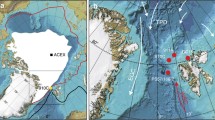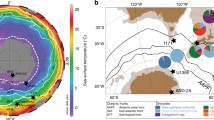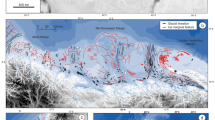Abstract
The sequence of events leading to the development of the modern Arctic Ocean ice-cover is imperfectly understood. Glacial-marine sediment was deposited during the early Pliocene and perhaps by the end of the late Miocene and this sediment type has continued to accumulate throughout the late Cenozoic to the present. The time of formation of the ocean’s ice-cover, whether ice has been continually present, and the relationship of the ocean’s sediment to the ice-cover have been debated. How geologically stable is the ice-cover? Is there evidence for significant change in the ice-cover during the late Cenozoic?
Arctic ice-cover origination probably depended upon such diverse activity as the formation of seasonal ice on Greenland, restricted circulation between the Arctic and North Atlantic Oceans, temperature/salinity changes in the North Atlantic — Greenland Sea, and enhancement of any or all of these events by orbitally driven insolation minima. Together with factors not recognized or poorly understood they resulted in the development of the first Arctic Ocean ice-cover.
Interpretations of the Arctic Ocean condition during the late Cenozoic include the idea of a continual warm ocean until approximately 2 Ma, a continually cold ocean with no permanent ice until 0.85 Ma, a probable warming of a cold Arctic Ocean around its margins at approximately 2 Ma, and a deep ocean warming event that resulted from increased ventilation of the Arctic Ocean at approximately 1.5 Ma. All of these ideas contrast, at least in part, with an unique idea that 1000 m thick ice occupied most of the Arctic Basin during the Pleistocene.
There are questions concerning the chronology for most of these interpretations, and with the limited evidence available it is possible that the proposed deep ocean ventilation at approximately 1.5 Ma and the warming of the Arctic borderlands interpreted to have occurred at approximately 2 Ma could represent a single event. Time of the initial late Cenozoic ice-cover formation may not be fixed without a major drilling activity in the central Arctic Ocean.
Access this chapter
Tax calculation will be finalised at checkout
Purchases are for personal use only
Preview
Unable to display preview. Download preview PDF.
Similar content being viewed by others
References
Aagaard, K., and P. Greisman: 1975, ‘Toward new mass and heat budgets for the Arctic Ocean’, J. Geophys. Res. 80, 3821–3827.
Aagaard, K., A. Foldvik, and S. R. Hillman: 1987, ‘The West Spitsbergen Current: Disposition and water mass transformation’, J. Geophys. Res. 92, 3778–3784.
Aksu, A. E.: 1985, ‘Paleomagnetic stratigraphy of the CESAR cores’, in H. R. Jackson, P. J. Mudie, and S. M. Blasco (eds.), Geological Report on CESAR: The Canadian Expedition to Study the Alpha Ridge, Arctic Ocean, Geol. Soc. Can. Paper 84–22, pp. 101–114.
Aksu, A. E., and P. J. Mudie: 1985, ‘Magnetostratigraphy and palynology demonstrate at least 4 million years of Arctic Ocean sedimentation’, Nature 318, 280–283.
Atkins, E. D.: 1988, ‘Calcareous microfossils in the Pliocene central Arctic Ocean’, unpubl. M.Sc. thesis, Univ. Wisconsin, Madison.
Carter, L. D., J. Brigham-Grette, and L. Marincovich: 1986. ‘Late Cenozoic Arctic Ocean sea ice and terrestrial paleoclimate’, Geology 14, 675–678.
Clark, D. L.: 1982, ‘Origin, nature and world climate effect of Arctic Ocean ice-cover’, Nature 300, 321–325.
Clark, D. L.: 1985, ‘The Eocene Arctic Ocean and Earth’s early Cenozoic climate’, Geol. Soc. Amer. Programs 17, 547 (abstr.).
Clark, D. L., and A. Hanson: 1983, ‘Central Arctic Ocean sediment texture: Key to ice-transport mechanism’, in B. F. Molnia, (ed.), Glacial-Marine Sediment, Plenum Press, New York, pp. 301–330.
Clark, D. L., R. R. Whitman, K. A. Morgan, and S. D. Mackay: 1980, ‘Stratigraphy and glacial-marine sediments of the Amerasian Basin, central Arctic Ocean’, Geol. Soc. Amer. Spec. Paper 181, 57 p.
Clark, D. L., J.-S. Vincent, G. A. Jones, and W. A. Morris: 1984, ‘Correlation of marine and continental glacial and interglacial events, Arctic Ocean and Banks Island’, Nature 311, 147–149.
Clark, D. L., M. Andrée, W. S. Broecker, A. C. Mix, G. Bonani, H. J. Hofmann, E. Morenzoni, M. Nessi, M. Suter, and W. Wölfli: 1986, ‘Arctic Ocean chronology confirmed by accelerator 14C dating’, Geophys. Res. Lett. 13, 319–321.
Clark, D. L., L. A. Chern, J. A. Hogler, C. M. Mennicke, and E. D. Atkins: in press, ‘Late Neogene climate evolution of the central Arctic Ocean’, Tectonophysics.
Dalrymple, R. W., and O. C. Maass: 1987, ‘Clay mineralogy of late Cenozoic sediment in the CESAR cores, Alpha Ridge, central Arctic Ocean’, Can. J. Earth Sci. 24, 1562–1569.
Darby, D. A.: 1971, ‘Carbonate cycles in Arctic sediment cores’, Tech. Rept. 8, Arctic Studies, Univ. Wisconsin, Madison, 43 p.
Fillon, R. H.: 1984, ‘Ice-age Arctic Ocean ice-sheets: A possible direct link with insolation’, in A. L. Berger, J. D. Hays, G. J. Kukla, and B. Saltzman (eds.), Milankovitch and Climate, Reidel, Dordrecht, pp. 223–240.
Fletcher, J. O.: 1972, ‘Ice on the ocean and world climate’, in Beneficial Modifications of the Marine Environment, Nat. Acad. Sci., Washington, pp. 4–49.
Fletcher, J. O., and J. J. Kelley: 1978, ‘The role of the polar regions in global climate change’, in M. A. McWhinnie (ed.), Polar Research, AAAS Selected Symposium Series, Westview Press, Boulder, pp. 97–116.
Funder, S., N. Abrahamsen, O. Bennike, and R. W. Feyling-Hanssen: 1985, ‘Forested Arctic: Evidence from North Greenland’, Geology 13, 542–546.
Gamber, J. H., and D. L. Clark: 1978, ‘Distribution of microscopic molluscs, echinoderms, and sponges in the central Arctic Ocean’, Micropaleont. 24, 422–431.
Gartner, S.: 1988, ‘Paleoceanography of the mid-Pleistocene’, Mar. Micropaleont. 13, 23–46.
Gilbert, M. W., and D. L. Clark: 1983, ‘Central Arctic Ocean paleoceanography interpretations based on Late Cenozoic calcareous dinoflagellates’, Mar. Micropaleont. 7, 385–401.
Herman, Y., and D. M. Hopkins: 1980, ‘Arctic Ocean climate in late Cenozoic time’, Science 209, 557–562.
Hughes, T. J., G. H. Denton, and M. G. Grosswald: 1977, ‘Was there a late Würm Arctic ice-sheet?’, Nature 266, 596–602.
Jones, G. A., and D. L. Clark: in prep., ‘Paleomagnetic data of central Arctic Ocean sediment cores’.
Keigwin, L. D.: 1982, ‘An Arctic Ocean ice-sheet in the Pleistocene?’, Nature 296, 808–809.
Kitchell, J. A., and D. L. Clark: 1982, ‘Late Cretaceous - Paleogene paleogeography and paleocirculation: Evidence of North Polar upwelling’, Palaeogeogr. Palaeoclimat. Palaeoecol. 40, 135–165.
Kukla, G. J., and H. J. Kukla: 1974, ‘Increases surface albedo in the northern hemisphere’, Science 183, 709–714.
Lamb, H. H.: 1974, ‘Atmospheric circulation during the onset and maximum development of the Wisconsin/Würm Ice Age’, in Y. Herman (ed.), Marine Geology and Oceanography of the Arctic Seas, Springer, New York, pp. 349–358.
Livingston, H. D., S. L. Kupferman, V. T. Bowen, and R. M. Moore: 1984, ‘Vertical profile of artificial radionuclide concentrations in the central Arctic Ocean’, Geochim. Cosmochim. Acta 48, 2195–2203.
Macko, S. A., and A. E. Aksu: 1986, ‘Amino acid epimerization in planktonic foraminifera suggests slow sedimentation rates for Alpha Ridge, Arctic Ocean’, Nature 322, 730–732.
Marquard, R. S., and D. L. Clark: 1987, ‘Pleistocene paleoceanographic correlations: Northern Greenland Sea to central Arctic Ocean’, Mar. Micropaleont. 12, 325–341.
McDougall, K. A., E. M. Brouwers, and P. Smith: 1986, ‘Micropaleontology and sedimentology of the BP borehole series, Prudoe Bay, Alaska’, U.S. Geol. Surv. Bull. 1598, 62 p.
Morris, T. H.: 1988, ‘Stable isotope stratigraphy of the Arctic Ocean’, Palaeogeogr. Palaeoclimat. Palaeoecol 64, 201–219.
Morris, T. H., and D. L. Clark: 1986, ‘Pleistocene calcite lysocline and paleocurrents of the central Arctic Ocean and their paleoclimatic significance’, Paleoceanography 1, 181–195.
Mudie, P. J., and S. M. Blasco: 1985, ‘Lithostratigraphy of the CESAR cores’, in H. R. Jackson, P. J. Mudie, and S. M. Blasco (eds.), Geological Report on CESAR: The Canadian Expedition to Study the Alpha Ridge,, Geol. Surv. Can. Paper 84–22, pp. 59–99.
Naidu, A. S.: 1974, ‘Sedimentation in the Beaufort Sea: A synthesis, in Y. Herman (ed.), Marine Geology and Oceanography of the Arctic Seas, Springer, New York, pp. 173–190.
O’Neill, B. J.: 1981, ‘Pliocene and Pleistocene benthic foraminifera from the central Arctic Ocean’, J. Paleont. 55, 1141–1170.
Östlund, H. G., G. Possnert, and J. H. Swift: 1987, ‘Ventilation rate of the deep Arctic Ocean from Carbon 14 data’, J. Geophys. Res. 92, 3769–3777.
Polar Research Board: 1985, National issues and research priorities in the Arctic, Nat. Res. Council, Washington, 124 p.
Repenning, C. A.: 1983, ‘New evidence for the age of the Gubik Formation, Alaska, North Slope’, Quat. Res. 19, 356–372.
Repenning, C. A.: 1984, ‘Quaternary rodent biochronology and its correlation with climatic and magnetic stratigraphies’, in W. C. Mahaney (ed.), Correlation of Quaternary Chronologies, Geo Books, Norwich, pp. 105–118.
Repenning, C. A., E. M. Brouwers, L. D. Carter, L. Marincovich, and T. A. Ager: 1987, ‘The Beringian ancestry of Phenacomys (Rodentia: Cricetidae) and the beginning of the modern Arctic Ocean borderland biota’, U.S. Geol. Surv. Bull. 1687, 31 p.
Ruddiman, W. K, M. E. Raymo, and A. Mclntyre: 1986, ‘Matuyama 41.000 year cycles: North Atlantic Ocean and Northern Hemisphere ice-sheets’, Earth Planet. Sci. Lett. 80, 117–129.
van Loon, H., and J. C. Rogers: 1978, ‘The seesaw in winter temperatures between Greenland and Northern Europe, Part I: General description’, Mon. Weather Rev. 106, 296–310.
Vincent, J.-S.: 1982, ‘The Quaternary history of Banks Island, N.W.T. Canada’, Geoff: Phys. Quat. 36, 209–232.
Vincent, J.-S.: 1983. ‘Géologie du Quaternaire et la Géomorphologie de l’Ile Banks, Arctique Canadien’, Geol. Surv. Canada Memoir 405,118 p.
Vincent, J.-S., W. A. Morris, and S. Ochietti: 1984, ‘Glacial and nonglacial sediment of Matuyama paleomagnetic age on Banks Island, Canadian Arctic Archipelago’, Geology 12, 139–142.
Vogt, P. R.: 1986, ‘Geophysical and geochemical signatures and plate tectonics’, in B. G. Hurdle (ed.), The Nordic Seas, Springer, New York, pp. 413–662.
Wigley, T. M. L., P. D. Jones, and P. M. Kelly: 1980, ‘Scenario for a warm, high CO2 world’, Nature 283, 17–21.
Williams D. F., W. S. Moore, and R. H. Fillon: 1981, ‘Role of Arctic Ocean ice-sheets in Pleistocene oxygen isotope sea level records’, Earth Planet. Sci. Lett. 56, 157–166.
Witte, W. K., and D. V. Kent: 1988, ‘Revised magnetostratigraphies confirm low sedimentation rates in Arctic Ocean cores’, Quat. Res. 29, 43–53.
Author information
Authors and Affiliations
Editor information
Editors and Affiliations
Rights and permissions
Copyright information
© 1990 Kluwer Academic Publishers
About this chapter
Cite this chapter
Clark, D.L. (1990). Stability of the Arctic Ocean Ice-Cover and Pleistocene Warming Events: Outlining the Problem. In: Bleil, U., Thiede, J. (eds) Geological History of the Polar Oceans: Arctic versus Antarctic. NATO ASI Series, vol 308. Springer, Dordrecht. https://doi.org/10.1007/978-94-009-2029-3_15
Download citation
DOI: https://doi.org/10.1007/978-94-009-2029-3_15
Publisher Name: Springer, Dordrecht
Print ISBN: 978-94-010-7410-0
Online ISBN: 978-94-009-2029-3
eBook Packages: Springer Book Archive




